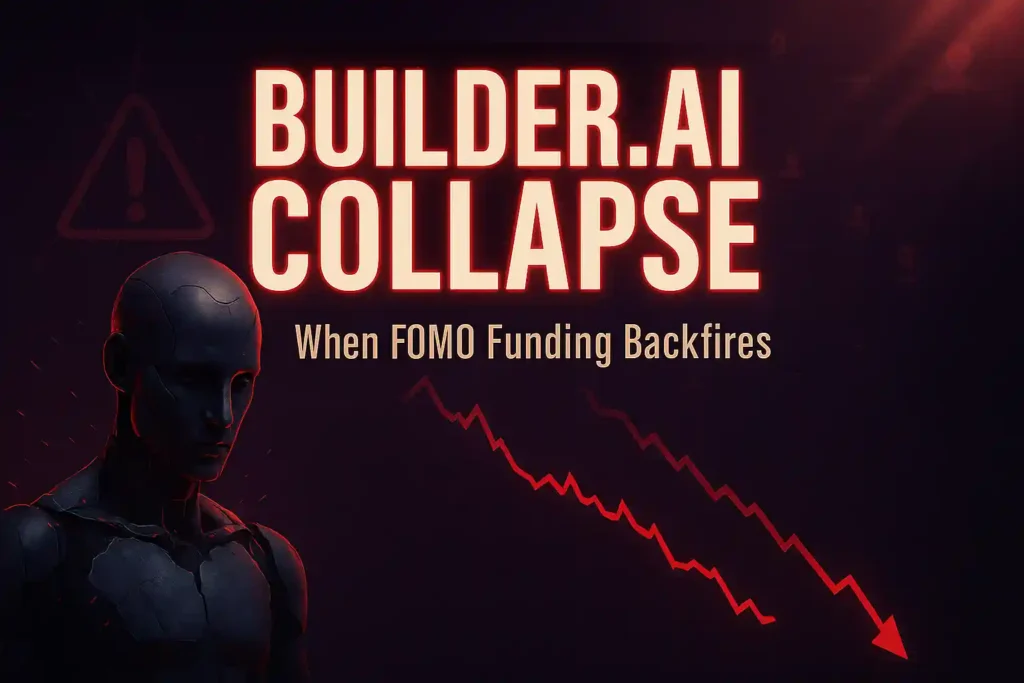In a stunning downfall, Builder.ai, a London-based startup once valued at $1.3 billion and backed by tech giant Microsoft, has filed for insolvency.
The company, which promised to revolutionize software development through artificial intelligence (AI), collapsed under the weight of financial missteps, accusations of “AI washing,” and unsustainable business practices.
This collapse has left customers scrambling and raised questions about investor due diligence in the tech sector, resonating with young professionals and tech enthusiasts across Europe and the UK.

The Rise and Fall of Builder.ai
Founded in 2016 by Sachin Dev Duggal, Builder.ai aimed to make software development accessible to everyone by leveraging AI to build applications.
The company quickly gained traction, raising over $445 million from high-profile investors, including Microsoft and Qatar Investment Authority (QIA). By 2021, it had achieved unicorn status with a valuation exceeding $1.3 billion, positioning it as a leader in the tech startup scene.
However, the dream unraveled. In May 2025, Builder.ai filed for insolvency, revealing it had only $5 million in cash left after lenders, including Viola Credit, seized $37 million.
The company’s new CEO, Manpreet Ratia, who took over just two months before the collapse, laid off most of the global staff, and the platform was shelved. Customers, primarily startups and small to medium-sized enterprises (SMEs), now face significant challenges rebuilding or migrating their applications.
Accusations of AI Washing and Financial Misrepresentations
Builder.ai’s collapse wasn’t just a financial failure—it was a reputational one. In 2019, The Wall Street Journal exposed the company for using Indian coders to perform work marketed as AI-driven, labeling it as “all engineer, no AI.” This practice, known as “AI washing,” involves presenting conventional technology as AI to attract funding and customers, a tactic that damaged Builder.ai’s credibility.
Additionally, the company faced accusations of inflating sales figures and misrepresenting its financial health to lenders. Reports suggest Builder.ai’s business model prioritized rapid scale over sustainability, leading to a fragile financial structure. These issues, combined with historic challenges and poor past decisions, triggered an irreversible collapse when lenders took action.
Investor Regrets and the FOMO Investing Trap
The downfall has sparked a broader conversation about investor behavior in the tech industry. Carrie Osman, CEO of Cruxy, highlighted “FOMO investing” as a key factor, where investors rush into deals driven by hype around technologies like Generative AI, often neglecting due diligence.
Osman criticized Microsoft and other investors for failing to assess Builder.ai’s true value and return on investment, suggesting they were swayed by headlines rather than substance.
This trend isn’t new. Osman compared Builder.ai’s collapse to other high-profile failures like Zymergen, Frank, and Theranos, which also saw inflated valuations followed by collapse.
The AI gold rush, fueled by the 2022 launch of ChatGPT, has intensified this issue. In 2023, 40% of US venture capital went to AI-focused funds, up from 10% in 2021, according to The Next Web.
This surge has led to the rise of “zombiecorns”—unicorns with poor revenue growth and unsustainable economics.
| Key Factors in Builder.ai’s Collapse | Details |
|---|---|
| Financial Troubles | Only $5M cash left after $37M seized by lenders; insolvency filed in May 2025. |
| AI Washing Accusations | Used human coders for work marketed as AI-driven, exposed in 2019. |
| Inflated Sales Figures | Misrepresented financial health, leading to loss of investor trust. |
| FOMO Investing | Investors like Microsoft rushed in without proper due diligence. |
| Unsustainable Model | Prioritized scale over sustainability, leading to collapse. |
Impact on Customers and the Tech Industry
Builder.ai’s collapse has left its customers—primarily startups and SMEs—in a difficult position. These businesses, which relied on the platform to develop their applications, now face additional costs and delays as they rebuild or migrate their apps. This disruption highlights the risks of depending on overhyped tech providers and the importance of vetting their claims.
The collapse also serves as a cautionary tale for the tech industry, particularly in Europe and the UK, where startup culture thrives among the 18-50 age group. It underscores the need for transparency, ethical practices, and rigorous investor scrutiny to prevent similar failures.
Conclusion
Builder.ai’s collapse is a stark reminder of the challenges facing the tech startup ecosystem. It highlights the dangers of overhyping technology, misrepresenting financial health, and rushing investments without due diligence.
For Europe and the UK’s tech community, particularly the 18-50 age group, this serves as a call for greater transparency and accountability in the industry. As the tech sector evolves, lessons from Builder.ai’s failure will be crucial in building more sustainable and trustworthy businesses.

Roshan Sharma – Founder of StocksForBeginners.in
I’m Roshan Sharma, a stock market trader with 5+ years of experience. At StocksForBeginners.in, I provide expert fundamental analysis of Indian companies to help long-term investors make informed decisions. My mission is to simplify investing for beginners and share insights from my experience to guide others toward financial growth.